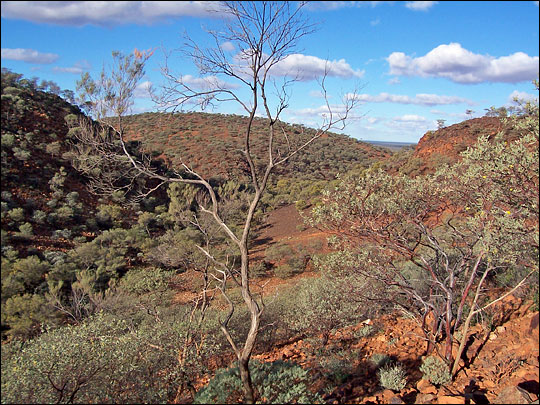

 | |||
The rain that fell on Bruce Watson and Mark Harrison as they collected rocks in Western Australia’s arid shrublands in June 2005 was a fitting epilogue to the two scientists’ previous year’s research, published in the journal Science the month before. The area around Western Australia’s Jack Hills had a reputation for being dry, barren and hot. It’s also home to the oldest Earth material scientists have ever found, and Watson and Harrison were there to replenish their supply. “Ironically,” said Watson, “it rained on us nearly every day.” |
|||
 | |||
 |
The scientists’ encounter with cool, wet weather where they expected a searing, parched landscape echoed the story that mineral crystals from the Jack Hills have begun to tell about the history of the very early Earth. The crystals appear to contradict the conventional notion that the first 500 million years of Earth’s history—the Hadean Eon—were a continuously violent and chaotic time, when endless volcanism and continual meteor bombardment kept a global magma ocean simmering across the surface of the newly formed planet. |
Deep in the Australian Outback under the sparse vegetation of the Jack Hills, scientists have uncovered secrets about conditions on the Earth over 4 billion years ago. Crystals within the rocks hint that the surface of the early Earth was cool and wet—not the roiling inferno that some theories and asteroid crater observations suggest. (Photograph copyright Bruce Watson, Rensselaer) | |

Instead, the chemical make up of the Jack Hills crystals suggests that they formed in the presence of liquid water, likely even an ocean. These crystals provide evidence that even the very early Earth was cooler and wetter than scientists used to think. A gentler Hadean could have permitted life to evolve far earlier in the planet’s history than scientists originally supposed. Evidence of the Earliest EarthIt’s hard for scientists to know exactly what went on during the Hadean because no one has found any rocks that survived Earth’s infancy. Scientists use the chemical and physical structure of rocks to infer not only how old they are, but also something about the conditions in which they formed. In the absence of Hadean rocks, scientists have relied on indirect evidence of what went on for 500 million years after the formation of the Earth about 4.57 billion years ago. Lunar observations and astronomical models of solar system formation paint a picture of a violent Earth, bombarded with meteors, covered with an ocean of magma, and boiling with volcanic activity. This fiery, Hades-like image gave rise to the period’s name. For many years, there was no direct evidence to challenge that picture. But in the early 1980s came the discovery in Western Australia of single grains of an extremely durable mineral crystal known as zircon. Even after they are recycled through countless generations of rock, zircon crystals retain hints about the physical and chemical conditions in which they formed. |
Low and smoothed by erosion, the Jack Hills aren’t too impressive as a mountain range. But mineral crystals have weathered out of the Jack Hills and washed into streams, and these crystals tell a fascinating story about how far back in Earth’s past the oceans might have formed. (NASA image by Robert Simmon, based on Landsat data provided by the Global Land Cover Facility) | ||

At the time, scientists didn’t immediately appreciate the full worth of the ancient zircons from Australia. “They were found out of context,” explained Watson, a geochemist from Rensselaer Polytechnic Institute, “weathered out of the rocks they had been embedded in and washed out into river sediment. Geologists didn’t think much verifiable ‘environmental’ information could be gleaned from them. And although the zircons were known to be old—the first really old zircons from the Jack Hills were dated at maybe 4.1 billion years old—we had rocks that were almost that old anyway.” |
The Jack Hills are remote and arid. The area is about 800 kilometers from the nearest city, Perth, and receives just over 20 centimeters of rain a year. Despite the difficult conditions, geologists explore the area in search of rock samples containing remnants of the earliest Earth. (NASA image by Robert Simmon and Reto Stöckli) | ||
 | |||
Since then, however, scientists have found zircons that date to almost 4.4 billion years ago. “That might not seem like a big difference—4.1 versus 4.4—but it is another 300 million years closer to the origin of the Earth,” said Watson. As the age of the zircons kept getting pushed back, interest among scientists grew, and they began to develop techniques for teasing information from the zircons. Among the first important discoveries, says Watson, came out in 2001. Analysis of the relative amounts of different isotopes of oxygen indicated that the ratio was skewed toward “heavy” oxygen-18, as opposed to the more common “light” oxygen-16. “When a geologist sees a heavy oxygen signature in rocks,” said Watson, “it’s commonly understood to be a sign that the rocks formed in cool, wet, sedimentary processes at the Earth’s surface.” Thus, the magma that eventually gave rise to the zircons might have been formed from what had once been sediments deposited on the floor of an ancient ocean. |
The bits and pieces of rocks that make up the Jack Hills rock formation are ancient—over 3 billion years old. Individual crystals of zircon within the rocks are 4.4 billion years old, only 150 million years or so younger than the age of the Earth itself. These crystals are the oldest fragments of the Earth yet found. (Photograph copyright Bruce Watson, Rensselaer) | ||